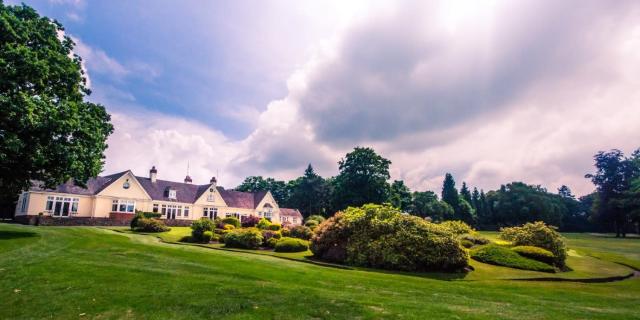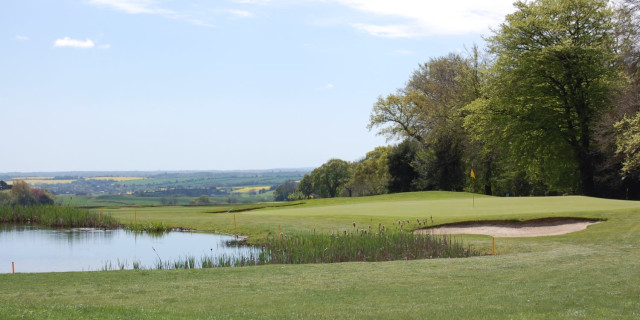Little Aston Golf Club Feature Review
Review by Golfshake Ambassador Kevin Heggie
Set within one of the most expensive areas of real estate in the country outside London, Little Aston is a highly regarded parkland-style course, which features regularly in a number of top 100 rankings. Due to its reputation, I was really looking forward to the visit, and I was intrigued as to quite how good a parkland course could be, given it is the style of course I play the most.
Prior to the round I received a warm welcome from the club manager, Iain Burns, who provided a great overview of the history of the course and a walk through the traditional styled members changing room, bar, and dining areas. Founded in 1908 within woodlands on well-draining, sandy soil, the original layout was created by Harry Vardon, before a further make over by Harry Colt. Colt left his mark in a number of ways, but the 87 bunkers certainly catch the eye as you navigate your way around the course. The overall course design is extremely fair, but as is synonymous with Colt’s design principles, it makes the golfer concentrate at every shot. Danger (predominantly in the form of those trademark bunkers) is never far away, and whilst the more accomplished golfers will take on the hazards generally in play on the ideal lines, it still allows those of all standards to figure out a way round and keep out of trouble.
Given its stature, there’s no surprise in finding Little Aston also has a rich pedigree in hosting major events for both Amateurs and Professionals. These cover tournaments such as the English Amateur/Brabazon Trophy, British Boys Championships, the Ladies British Open Amateur Championship, the English Ladies Amateur and Strokeplay Championships and the Dunlop Masters Professional Tournament. Little Aston is also supportive of junior golf, with the Grand Finals of the Robert Rock Junior Golf Tour taking place later in the year. Iain also emphasised that whilst it’s a members course, it’s very much open to visitors and societies groups, and is increasingly popular with those looking to cross off one of the best courses the midlands, and the country, has to offer.

The Putting Green
With the exception of St Andrews and the Himalayas, there are not many course reviews which would have a section on the putting facilities, but Little Aston is one. One of the main features of the club is a 9-hole putting course sitting proudly in front of the patio area, which weaves its way around numerous beds of extremely well-maintained flowers and shrubs. Unsurprisingly Little Aston takes great pride in this, ensuring the speeds match those found on the course, as well as running knockout events for its members during summer evenings. It is certainly something you should take a good amount of time to experience on your visit.

Front 9 Overview
The first couple of holes, both par 4s, ease you into the round and give you a good appreciation of what's to come with the 2nd playing the opposite way to the 1st. Cavernous bunkers are in play from the tee boxes, in the perfect place to cause the average golfer to think twice before blindly grabbing the driver, and the greens show their characteristics with subtle slopes and borrows.
The par 5 3rd takes it up a notch, presenting a great chance of birdie, but also the risk of racking up a big score. From the tee the fairway sweeps downhill, and you need to navigate a right-hand bunker around 200 yards away to reach the funnel of the fairway. It is then all about the second shot, as you are faced with a shot back uphill challenging you to avoid the bunkers of various sizes which cascade down from the green. The bold play will require a long accurate shot to avoid the bunkers around the green, but the layup still requires precision. Both my playing partner and I opted for the safer play and avoided taking on majority of the bunkers, but still gave ourselves fair opportunities for birdie putts.
The 4th is an unusual short par 4, in that it is SI 1, but isn’t in fact the hardest hole on the course (the SI is set for matchplay purposes, to force the better player to try to birdie the hole if they wish to win it). The first of Colt’s trademark diagonal bunkers runs across the front of the fairway to add some visual intimidation for the shorter hitters, whilst the longer hitters will be tempted to drive it up the green, which slopes significantly front and back.

The first of the par 3s follows, playing around 160 yards. The hole is framed beautifully by bunkers front, left, and long, with a large oak in the back to aim for. This green also is one of the more complex on the property, with numerous pin positions available to add to the challenge.
Three enjoyable par 4s follow with heathland tinged mounds and fairways which switch direction as you make your way down, up, and down again. The hole designs are timeless - bunkers await in the typical landing zones, so judging distance and position is key for your second shots into yet more nuanced greens with significant bunker protection. Finally, another picture postcard par 3 is cut into the trees and plays shorter than the yardage due to the downhill nature of the hole, and it’s a good chance for birdie to close out the front 9.

Back 9 Overview
The back 9 starts with one of the toughest par 4s on the course, playing well over 400 yards slightly uphill, and will require a long approach shot for most to get to the green in two. The next is a great par 4. Not long but dotted with a triangle of bunkers which defines the perfect landing zone and are ready to catch anything slightly offline. A dead straight par 5 follows, which again whilst was not particularly long still has enough protection from the tee to cause issues and has a picturesque lake around 100 yards and in to grab your focus.
A quick stroll through the woodland and you come across another stunning par 3, with bunkers galore to catch anything offline, and only a narrow opening at the front to run the ball through. From here, a short par 4 awaits at the 14th, with a huge bunker running across the doglegged fairway, where anything right will likely see you blocked from the green. Find the fairway, and you are approaching a relatively small, narrow green, with a false front hurting anything short (which I found to my cost).

The final stretch at Little Aston starts with another signature hole, the longest and toughest of the par 5s. From the tee there is a mix of bunkers and humps on the horizon, which only the longest would be able to cover. Further protection is also provided by the only two-tiered green on the property, with the back pin particularly difficult to attack.
The par 4 16th is a relative anomaly in terms of design versus the rest of the holes, as there are no bunkers in play from the elevated tee. Rather, the hazards are pushed up towards the green which slopes significantly from back to front, taking out the option of running the ball into the green. The 17th was redesigned in 2006, with the green pushed into the lake which now protects it. This downhill par 4 may tempt the long hitters, but the new position of the green as well as its many slopes and borrows have really made this a signature hole. Finally, the 18th doglegs back towards the traditional clubhouse, with another deep bunker surrounding the entire front part of the green.

Verdict
As mentioned at the start, I came with high expectations, but I was still blown away by the quality and playability of the course in stunning surroundings, with exceptional pace of play. Overall, I was happy with how I played given it was my first visit, but on the few occasions when I failed to concentrate or properly consider my options I soon found myself in trouble and kicking myself for taking the wrong shot or club choice.
I loved the par 3s, very friendly in distance without being too short, giving most golfers chances for birdies if they strike their tee shot well. The course didn’t seem to play as long as the yardage would have suggested, making it accessible for all golfers, and I enjoyed the flow of the holes, in that no two played in the same direction, so you’re faced with different perspectives, elevation changes, and wind directions at every turn. Additionally, from each green you usually begin to see what is waiting on the next hole, with no significant walks between holes required. Whilst there are obvious standout holes in 3, 14, 15, and 17, I would argue that there isn’t really a weak hole on the course, and the back 9 in particular is a joy to behold.

Due to the COVID-19 situation at the time of visit I was unable to experience the full Little Aston experience around the clubhouse with the bar and catering closed, but the tour I received from Iain certainly whetted the appetite to come back, sit out on the patio area after a round of golf and maybe play a round (or two) on the putting green with a drink in hand.
Value for money is always a personal view, and it is unlikely that you would regularly play the course as a visitor. However, in my view the quality of the course justifies the green fee, and Little Aston deserves its place in those top 100 rankings as one of the best (if not the best) parkland courses in the country (and if it was 100 miles south in Surrey I’m sure you would be paying even more!). For those golfers who only think about The Belfry when planning a golf trip to the Midlands, I’d highly recommend adding an extension to visit this course, or even creating a DIY tour covering Little Aston, Beau Desert, Sutton Coldfield, or Whittingham.
Overall Rating - 10
Course (Conditions) - 10
Course (Hole Variety/Layout) - 10
Course (Green Condition) - 10
Course (Challenge/Difficulty) - 9
Practice Facilities -10
Friendliness/Hospitality - 10
Pace of Play - 10
Value for Money - 9
Related Content: travel review England Courses

















